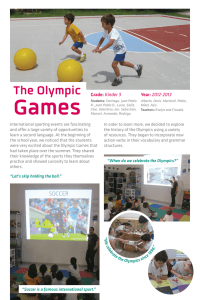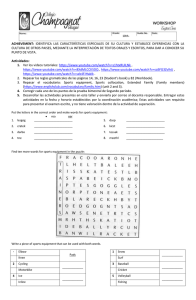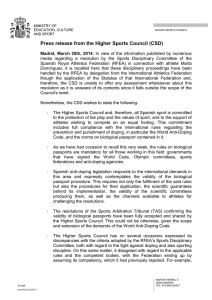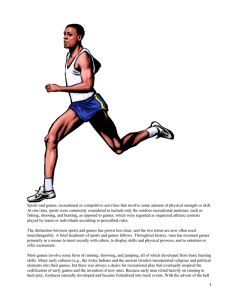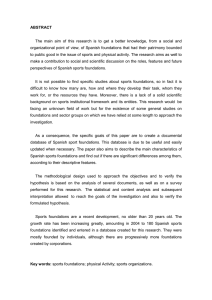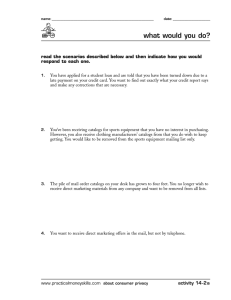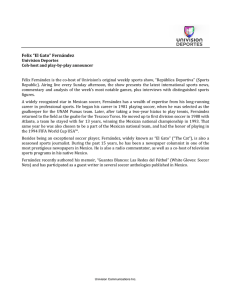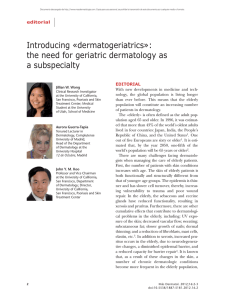original gender differences in motivations to practice physical activity
Anuncio
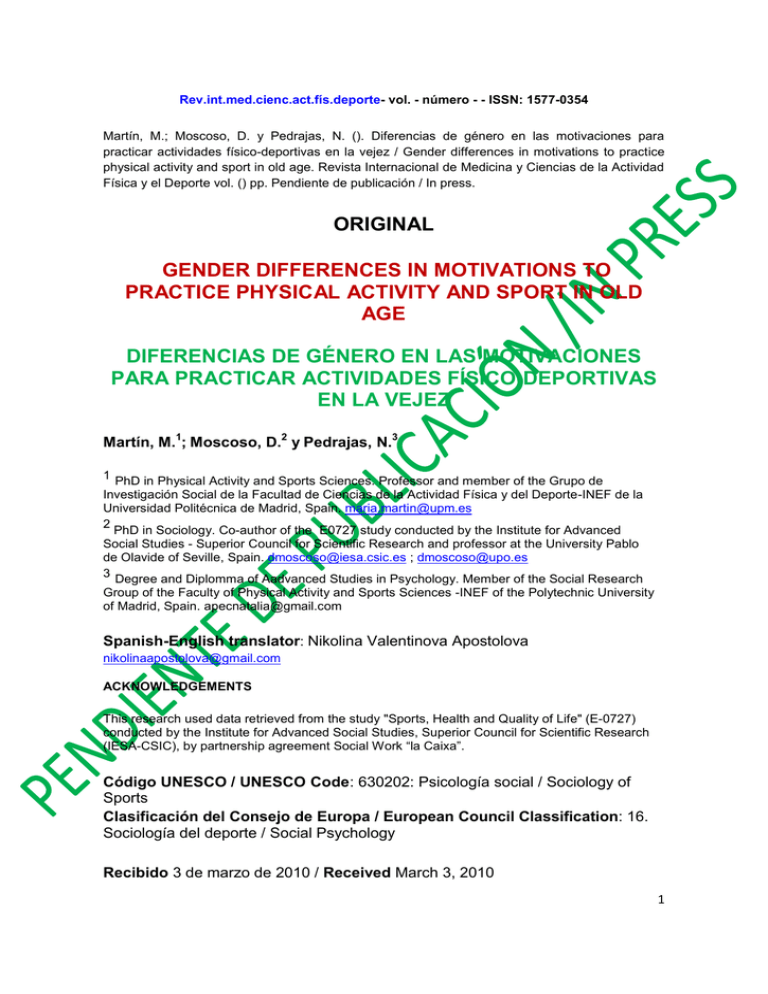
Rev.int.med.cienc.act.fís.deporte- vol. - número - - ISSN: 1577-0354 Martín, M.; Moscoso, D. y Pedrajas, N. (). Diferencias de género en las motivaciones para practicar actividades físico-deportivas en la vejez / Gender differences in motivations to practice physical activity and sport in old age. Revista Internacional de Medicina y Ciencias de la Actividad Física y el Deporte vol. () pp. Pendiente de publicación / In press. ORIGINAL GENDER DIFFERENCES IN MOTIVATIONS TO PRACTICE PHYSICAL ACTIVITY AND SPORT IN OLD AGE DIFERENCIAS DE GÉNERO EN LAS MOTIVACIONES PARA PRACTICAR ACTIVIDADES FÍSICO-DEPORTIVAS EN LA VEJEZ Martín, M.1; Moscoso, D.2 y Pedrajas, N.3 1 PhD in Physical Activity and Sports Sciences. Professor and member of the Grupo de Investigación Social de la Facultad de Ciencias de la Actividad Física y del Deporte-INEF de la Universidad Politécnica de Madrid, Spain. maria.martin@upm.es 2 PhD in Sociology. Co-author of the E0727 study conducted by the Institute for Advanced Social Studies - Superior Council for Scientific Research and professor at the University Pablo de Olavide of Seville, Spain. dmoscoso@iesa.csic.es ; dmoscoso@upo.es 3 Degree and Diplomma of Aadvanced Studies in Psychology. Member of the Social Research Group of the Faculty of Physical Activity and Sports Sciences -INEF of the Polytechnic University of Madrid, Spain. apecnatalia@gmail.com Spanish-English translator: Nikolina Valentinova Apostolova nikolinaapostolova@gmail.com ACKNOWLEDGEMENTS This research used data retrieved from the study "Sports, Health and Quality of Life" (E-0727) conducted by the Institute for Advanced Social Studies, Superior Council for Scientific Research (IESA-CSIC), by partnership agreement Social Work “la Caixa”. Código UNESCO / UNESCO Code: 630202: Psicología social / Sociology of Sports Clasificación del Consejo de Europa / European Council Classification: 16. Sociología del deporte / Social Psychology Recibido 3 de marzo de 2010 / Received March 3, 2010 1 Aceptado 28 de junio de 2011 / Accepted June 28, 2011 ABSTRACT The aim of this study is to analyze possible gender differences in motivations to practice physical sporting activity and in old age. The methodology consisted in carrying out a computer assisted telephone interview (CATI), using a structured questionnaire, to a randomly selected sample of the elderly Spanish population (800, 440 women and 360 men between 65 and 79 years old). Elderly women and men combine extrinsic motivations, such improving and maintaining physical fitness related to health (62,1% women, 60% men) and intrinsic motivations, as enjoying the activity (33,3% women, 32% men). The motives related to social relationships, as fun, leisure time occupation and medical advice have a greater influence on women than men while men refer to the importance of previous practice on the current practice. The findings suggest that programmes to promote physical and sporting activity and in older adults should consider these differences. KEY WORDS: Elderly, motivations, gender differences, physical activity, sport. RESUMEN El objetivo de este estudio es analizar las posibles diferencias de género en las motivaciones por las que las personas mayores practican actividades físicodeportivas. La metodología cuantitativa empleada ha sido entrevista telefónica asistida por ordenador (CATI) a una muestra representativa de la población de mayores en España (440 mujeres y 360 varones entre 65 y 79 años). En mujeres y hombres mayores se conjugan principalmente motivaciones de carácter extrínseco, relacionados con el cuidado y mejora de la salud (62,1% mujeres, 60% hombres), y de carácter intrínseco, como el gusto por la actividad (33,3% mujeres, 32% hombres). Las motivaciones de carácter social, como divertirse, ocupar el tiempo o la recomendación médica tienen una influencia mayor en mujeres mientras que los hombres se refieren a la importancia de la práctica anterior en la práctica actual. Los resultados sugieren que los programas de actividades físico-deportivas para personas mayores deben considerar estas diferencias PALABRAS CLAVES: Personas mayores, género, actividades físico- deportivas. motivaciones, diferencias de 1. INTRODUCTION In Spain, the recent Comprehensive Plan for the Promotion of Sports and Physical Activity in Elderly People (CSD, 2009) highlights the importance of being physically active in old age and the need of facilitating the access of elderly 2 people to exercise programmes adapted to their motivations, interests and needs. Literature review suggests that the most important motivational factors for elderly people to be physically active are those related to physical health, social relationships and self-competence (Jiménez-Beatty et al., 2007). Several studies have tried to specify the motivations of elderly people in Spain to practice sporting and physical activity. The last national survey on sports habits, conducted by the Center for Sociological Research (CIS) and funded by the National Sports Council (CSD), shows that people fifty-five and over who do physical exercise do it primarily in order to improve health and fitness, namely: doing physical exercise (60%) and maintaining and/or improving health (54%), these motives having much higher rates than others such as fun and use of leisure time (30%), joy of sports (26%), meeting friends (14%), staying in shape (10%) and enjoying competition (1%). García Ferrando (2006) indicated no gender differences in the motivations of elderly people for sports, though, AS FAR AS regarding the differences between women and men between 15 and 74 ARE CONCERNED he specifies that women cite a greater proportion of fitness, health and physical appearance related motives, while men emphasize the pleasure of dedicating their leisure time to it and the joy of sports. A study conducted by the Women´s Institute (2006) agrees with this tendency, showing that, amongst the same age range the majority of people who do physical exercise (90% approximately) does it for health reasons, and this regardless of sex, despite being more relevant among women than among men, highlighting the fact that sports, as age increases, are performed as activity directed at health care. A study by Martin et al. (2010) addresses precisely this relationship in a random sample of elderly people in Spain, looking for possible gender differences in practicing sporting and physical activity. With this aim, the 17 items JiménezBeatty et al.´s (2007) Motivation Scale for Physical Activity in Elderly People is used. The results show that the health-related motives appear as the first category among elderly people for doing sports, social benefits being the second largest group of motives. By contrast, the competition and self-efficacy motives are given less importance. As priority motives women identify maintaining or improving health, feeling good, having fun and pleasure of the activity itself, while in men, the most outlined motives are maintaining or improving health, getting fit, pleasure of the activity itself and feeling comfortable. Although no significant gender differences are observed, certain tendency, to be considered in designing sports programmes for 3 this population, was found, in particular, that the reasons related to social relationships, self-efficacy and competence have a major influence on women. In smaller geographical areas, and using the same instrument, Jimenez-Beatty et al. (2007), in the municipality of Madrid, and Jimenez-Beatty, Martinez del Castillo and Graupera (2006), in the Guadalajara province, also found no significant differences between men and women in the motives for practicing physical and sporting activities. 2. OBJETIVES 1. Determine the motivations driving elderly people in Spain to practice physical and sporting activities. 2. Analyse gender differences in motivations to practice physical and sporting activities among elderly people in Spain. 3. MATERIALS AND METHODS In order to carry out this research, we used the data from the study "Sports, Health and Quality of Life" (E-0727) conducted by the Institute for Advanced Social Studies, Superior Council for Scientific Research (IESA-CSIC), by partnership agreement with Social Work “la Caixa”. The quantitative methodology used has been a computer-assisted telephone interview (CATI) to a sample of elderly people, representative of this population in Spain (800 people between 65 and 79 years, 440 females and 360 males). Sampling was stratified; gender and age being the control variables for the entire sample selected via mobile phone, and along with these two variables, province and size of habitat were used for the sample selected via landline number. The distribution of the sample selected via landline or mobile phone was estimated by minimizing the sample variance. Finally, the error level assumed was ± 3.5%. From this sample of the population, we used a sub-sample represented by those who claim to practice sports, which constitutes the 36.7% of the total sample of the population used for the study. The questionnaire included questions related to sex, age and sports practice. Related to the motives for this practice, the same question as the one used in the Sports Habits in Spain survey (García Ferrando, 2006) was formulated, "Can you tell me the main reasons why you practice sports?". The difference lays in the fact that, while the Sports Habits in Spain survey opts for a closed-ended question (multiple choice: maximum of three answers), in the present study we chose an open-ended question (maximum of three answers) that allowed us to deepen further and gave us more complete and less biased information. Being an open question, the interviewer wrote down a maximum of three answers exactly the way the interviewee had expressed them. Subsequently, answers were grouped configuring the new variables. For the statistical treatment of data SPSS, 12.0 and 15.0 have been used. 4 4. RESULTS Regarding the first analytical perspective Table 1 shows that the main motivation to practice is the intrinsic joy of sports (31.5%) although the set of motivations indicated by greater number of elderly people is related to health such as maintaining and improving health (28.8%), improving health problems (22.4%), physical and psychological wellbeing (10.4%) or medical advice (9.6%). With a contribution smaller than 10% we find some motives of social nature such as fun, habit or meeting friends. TABLE 1. Motivations for sports practice in elderly people MOTIVATIONS FOR PRACTICE Percentages SOCIAL INTRINSIC. Enjoying sports 31.5 HEALTH 1. Maintaining and/or improving health 28.8 HEALTH 2. Health problems 22.4 HEALTH 3. Physical and psychological wellbeing 10.4 HEALTH 4. Medical advice 9.6 SOCIAL 1. A habit, always done it 7.2 SOCIAL 2. Having fun and enjoying their time 6.5 SOCIAL 3. Because it adapts to their conditions/circumstances 2.3 AESTETHICS. Staying fit 1.8 HEALTH 5. Doing physical exercise 1.5 SOCIAL 4. Meeting friends 1.2 Other 6.7 Regarding the second analytical perspective, Table 2 shows the differences between women and men in their motivations for practicing physical and sporting activities. TABLA 2. Motivations for sports practice in elderly men and women MOTIVATIONS FOR PRACTICE MAN WOMAN SOCIAL INTRINSIC. Enjoying sports 32.0 33.3 HEALTH 1. Maintaining and/or improving health 32.0 25.0 HEALTH 2. Health problems 24.0 21.9 HEALTH 3. Physical and psychological wellbeing 4.0 15.2 HEALTH 4. Medical advice 4.0 12.5 5 HEALTH 5. Doing physical exercise 4.0 0.0 SOCIAL 1. A habit, always done it 12.0 3.1 SOCIAL 2. Having fun and enjoying their time 4.0 6.3 SOCIAL 3. Because it adapts to their conditions/circumstances 4.0 3.0 SOCIAL 4. Meeting friends 0.0 3.0 AESTETHICS. Staying fit 0.0 3.0 COMPETICIÓN. Porque le gusta competir 0.0 0.0 Other 4.0 6.3 The joy of sports is the main motivation for practice in women (33.3%) whereas in the case of men the joy of sports (32%) is as important as maintaining or improving health (32 %). It is observed in both sexes that the set of extrinsic motives related to health and welfare (maintaining or improving health, physical and psychological wellbeing), are the reasons that, as a whole, have the highest influence in sports practice (62.1% in women and 60% in men), although men compared to women consider preventive and therapeutic motives more important (maintaining and improving health: 32% in men and 25% in women, health problems: 24% in men and 21.9% in women) while women consider more important the effects that physical activity has on improving physical and psychological wellbeing (15.2 % in women and 4% in men). Medical advice is the fifth most important motive for both sexes, although women mention it more (12.5%) than men (4%). Following the health and joy of sports related motives we find those that are social in nature, such as practicing because of being a habit, which is reported by a greater number of males (12%) than females (3 , 1%), for fun and enjoying time being more important to women (6.3%) than to men (4%), adapting to one´s conditions and circumstances (4% males and 3% women) or meeting friends being more important to women (3%) than to men (0%). 5. DISCUSSIÓN The results of this study coincide with those obtained in the 2005 CIS survey, the Institute of Women´s (2006) study and the study conducted by Martin et al. (2010), in which elderly people practice sports mostly for health related reasons. They also coincide with those obtained in the 2005 CIS survey and study of Martin et al. (2010), in which the intrinsic joy of sports has become one of the main motives for the elderly of both sexes to practice. However, in this study some differences from the 2005 CIS survey and the study 6 conducted by the Institute for Women (2006) are observed, which may be due, amongst other reasons, to the fact that these studies provide results referring to people over 50 and 55 years respectively, or to differences in the measuring instrument. Regarding the second objective of the analysis, namely the differences between elderly women and men in relation to the motivations for practicing physical and sporting activity, the results coincide with those obtained by Martin et al. (2010), in verifying that the health and joy of sports related motivations are the most cited by both sexes and that women are more influences than men by the motives related to enjoyment and social relations. By contrast, while in the study of Martin et al. (2010) medical recommendation for practice is an equally important motive for both sexes, in the present study it is a motive important for more women (12.5%) than men (4%). These differences could be due to the different measuring instruments used. Likewise, this fact could explain that in this study motives related to self-efficacy and competence did not appear. The use of an open-ended question has allowed us to deepen further and has rendered more complete and less biased information than the surveys by García Ferrando (2006), while providing evidence that the Motivation Scale for Physical Activity in Elderly People Jimenez-Beatty et al. (2007) includes the motives most referred by elderly people to practice physical and sporting activities. One of the motives given by 12% of men and 3.1% of women that is not referred in the above studies and whose detection has been possible through the use of an open-ended question is the "habit/fondness" motive, most important amongst men than women, probably due to the fact that in these generational cohorts we find a greater number of men than women who have practiced sports in the prior age range. The importance of this factor has been previously identified by Martínez del Castillo et al. (2006). 6. CONCLUSIONS There are no significant differences observed by gender, but some tendencies have been found that should be considered when designing sports programmes targeting elderly women and men. In elderly women and men, mainly intrinsic and extrinsic motivations are combining, such as the joy of the activity and health care, although women consider more important the effects that physical activity has on improving one´s physical and psychological wellbeing while men are more concerned about preventive and therapeutic motives. With regard to the social motivations women mention more fun, leisure time and medical advice, while men refer to the importance of past practice on current practice. These data provide evidence about the strong extrinsic component maintaining and improving physical fitness for health reasons represent and others intrinsic in nature, such as the joy of the activity and should be considered as a benchmark in the design, organization, development and provision of programmes for 7 physical and sporting activity for the elderly people. 7. REFERENCES Consejo Superior de Deportes (2009). Plan Integral para la promoción del Deporte y la Actividad Física en personas mayores Libro. Madrid: Autor. García Ferrando, M. (2006). Posmodernidad y Deporte: Entre la individualización y la masificación. Encuesta sobre hábitos deportivos de los españoles 2005. Madrid: Consejo Superior de Deportes y Centro de Investigaciones Sociológicas. Instituto de la Mujer (2006). Actitudes y Prácticas Deportivas de las Mujeres en España (1990-2005). Madrid: Instituto de la Mujer. Jiménez-Beatty, J.E., Martínez del Castillo, J. y Graupera Sanz, J.L. (2006) . Las Administraciones públicas de la Provincia de Guadalajara y la integración social de las personas mayores a través de los servicios sociales de actividad físico-deportiva. Alcalá de Henares: Universidad de Alcalá-Ibercaja. Jiménez-Beatty, J.E., Graupera, J.L., Martínez del Castillo, J., Martín, M., Campos, A. (2007). Motivational factors and physician’s advice in physical activity in the older urban population. Journal of Aging and Physical Activity, Vol. 15, 3: 241-256. Martín, M.; Martínez del Castillo, J.; Jiménez-Beatty, J.E. y Ferro, S. (2010). Gender Differences in motivational factors to be physically active in old age. Journal of Sport and Science (en prensa) Martínez del Castillo, J.; Jiménez-Beatty J.E.; Graupera, J.L. y Rodríguez, M.L. (2006). Condiciones de vida, socialización y actividad física en la vejez. Revista Internacional de Sociología Vol 64, 44: 39-62. Referencias totales / Total references: 7 (100%) Referencias propias de la revista / Journal's own references: 0 (0%) Rev.int.med.cienc.act.fís.deporte- vol. - número - - ISSN: 1577-0354 8
